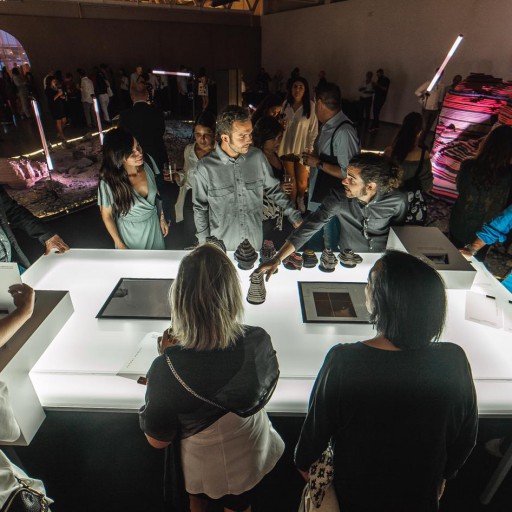Imagine a chair that automatically adjusts to your preferred posture as soon as you sit down. A table that charges your electronic devices without the need for cables. Or a mirror that advises you on what to wear for work or in which you can watch television. This is not a science fiction movie but technology already integrated into homes that improves our quality of life, well-being, and comfort.
Ver esta publicación en Instagram
Technological advances are becoming an increasingly important part of our lives and are more present in our homes. These gadgets make our daily lives easier and more efficient. And every year, more are devised. The latest edition of CES (Consumer Electronic Show), the world’s largest consumer electronics industry fair held in Las Vegas, has once again surprised us with a variety of home consumption inventions, some of them very curious.
A smart toilet with Alexa
Manufactured by the American company Kohler, this toilet stands out for having a seat, the PureWash E930, which costs nearly 2,000 euros and integrates smart technology and LED lighting. It can respond to movement to open and close the lid hands-free, and incorporates a self-cleaning ultraviolet light to ensure hygiene with every use. The most surprising thing is that it can be controlled by voice through Alexa or Google Assistant and can take commands to, for example, activate the bidet spray. The toilet seat also offers different washing modes, with adjustable water temperature and pressure, and the choice of oscillating or pulsating jets. Additionally, the seat can be heated if it’s cold, has a warm air drying system, and a child mode that ensures gentle washing.
Ver esta publicación en Instagram
Bulbs that “know” that the face is the mirror of the soul
The company Lepro has innovated by bringing AI to its facial recognition bulbs. By uploading a selfie to the app or stating how you feel, it syncs the user’s home lighting with their mood. Additionally, the bulbs are equipped with an algorithm that simulates the human auditory system and modulates the lights according to the music playing at the time.
Ver esta publicación en Instagram
Indoor plants designed to purify the air
In this case, it is a French startup, Neoplants, that created a type of plant capable of cleaning the air 30 times more effectively than a regular plant. As they are designed through bioengineering—they have been introduced with a gene that makes them absorb air pollutants and then convert them into plant matter—they are only sold in the United States, where genome modification of plants is permitted.
Ver esta publicación en Instagram
Smart anti-snoring pillow
Another technological innovation presented at CES 2024 undoubtedly contributes to improving the well-being of those who use it to sleep and even their bed partners. The DeRUCCI smart anti-snoring pillow alleviates snoring for those who rest their head on it. When the device detects snoring, it adjusts the person’s head position (without waking them up) and can reportedly reduce snoring by up to 89%.
Ver esta publicación en Instagram
Among ergonomic pillows, the Simba Hybrid from the British mattress brand Simba stands out for its innovative system that allows temperature and height adjustment through a filling structure made of nanocubes, small and innovative open-cell memory foam cubes that offer customizable support for the neck and head and allow air to circulate inside the pillow.
Ver esta publicación en Instagram
Technology and design, hand in hand
The functionality that technology offers to the home should not, however, clash with interior design. Until recently, it was perceived as invasive, perhaps because many of the gadgets and devices appeared cold or strange, out of place. But devices have evolved and adapted their aesthetics to facilitate their integration into spaces like the home, where design is fundamental.
Thus, the concept of technological interior design was born, combining the essence of both worlds and allowing the enjoyment of the possibilities and advantages of technology without sacrificing the careful and visually pleasing design of homes and work environments.
A few years ago, the FurniQi side table demonstrated this, adapting both to the living room or bedroom of the house and to the office. Its natural, delicate, and elegant design, with a Scandinavian style and bamboo wood finish, is perfectly compatible with its most innovative function: charging the mobile phone just by placing it on the table.
Ver esta publicación en Instagram
A bright floating garden
Back to the plant world, the company Vibia goes a step further and combines technology and furniture in Palma, a lighting system that connects light and vegetation, creating a hanging garden with almost imperceptible cables and two classic white glass globes joined by an aluminum strap, reinvented as a suspension lamp with plants along its axis, or vice versa: as a planter transformed into a lamp.
Ver esta publicación en Instagram
The mirror that gives you a health check from home
Named Anura Health, this mirror scans you to detect your stress level, if your face shows signs of any illness, and if the muscle mass it perceives is correct. It even asks some questions before giving a diagnosis. The health state detection is complemented by other gadgets that measure heart rate, blood pressure, respiration, and perform a small electrocardiogram to determine if you need to see a doctor.
Ver esta publicación en Instagram
And what can we expect in the future of technological interior design?
There is still much to see in the field of technological interior design. More screens in homes (hidden so they go unnoticed, for example using mirror screens, or displayed, emphasizing their use), more steps in the field of home automation (focused on improving security, sustainability, and design), and more use of new smart materials (that change color, shape, absorb and emit light, can be transformed…).
We will also see LiFi technology (short for light fidelity), a type of wireless connection that transmits information through LED light, which is being developed and can be up to one hundred times faster than WiFi (wireless fidelity), and a new generation of multi-device mirrors with augmented reality. All to make our lives more comfortable and easier.




